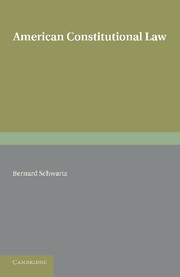Book contents
- Frontmatter
- Dedication
- Contents
- Foreword
- Preface
- PART I THE STRUCTURE
- PART II MODERN DEVELOPMENTS
- Chapter VI The New Federalism
- Chapter VII Presidential Prerogative and the Steel Seizure Case
- Chapter VIII The Changing Role of the Supreme Court
- Chapter IX The Negro and the Law
- Chapter X Civil Liberties and the 'Cold War
- Chapter XI Administrative Law
- Chapter XII The United States and the United Nations
- Appendix: Constitution of the United States of America
- Index of Cases
- General Index
Chapter VIII - The Changing Role of the Supreme Court
from PART II - MODERN DEVELOPMENTS
Published online by Cambridge University Press: 05 June 2016
- Frontmatter
- Dedication
- Contents
- Foreword
- Preface
- PART I THE STRUCTURE
- PART II MODERN DEVELOPMENTS
- Chapter VI The New Federalism
- Chapter VII Presidential Prerogative and the Steel Seizure Case
- Chapter VIII The Changing Role of the Supreme Court
- Chapter IX The Negro and the Law
- Chapter X Civil Liberties and the 'Cold War
- Chapter XI Administrative Law
- Chapter XII The United States and the United Nations
- Appendix: Constitution of the United States of America
- Index of Cases
- General Index
Summary
In 1948, Professor Friedmann called attention to what he termed the ‘fundamental changes of legal ideology reflected in the jurisdiction of the Supreme Court of the United States during the past ten years’. That such changes have occurred must be evident to anyone who has observed the work of that tribunal. What is perhaps not so apparent to the British observer is the extent of such change, which has been characterized by a leading American constitutional lawyer as ‘Constitutional Revolution, Ltd.’
To the outsider, the most striking characteristic of the American constitutional system is the doctrine of judicial supremacy. ‘No feature in the Government of the United States’, writes Lord Bryce, ‘has awakened so much curiosity in the European mind, caused so much discussion, received so much admiration, and been more frequently misunderstood, than the duties assigned to the Supreme Court and the functions which it discharges in guarding the ark of the Constitution.’ Under the doctrine of judicial supremacy, it has been the American Supreme Court that has determined conflicts between acts of government and the Constitution, and it has done so through the technical forms of the lawsuit. ‘These lawsuits’, states a justice of the Supreme Court, ‘are the chief instruments of power in our system. Struggles over power that in Europe call out regiments of troops, in America call out regiments of lawyers.’
It is precisely this aspect of the American system—what has been termed ‘government by lawsuit’—that is most difficult for the foreigner to comprehend. In February 1935, the federal Supreme Court by a bare majority, in effect, upheld the power of the Congress to lower the gold content of the dollar. The holder of a railroad bond bearing an interest coupon payable in gold of face value of $22.50 which had been issued before the gold content of the dollar had been lowered, demanded $38.10 in payment after devaluation, but the court held that he was required to accept the face value of the coupon in the new dollars.
- Type
- Chapter
- Information
- American Constitutional Law , pp. 207 - 221Publisher: Cambridge University PressPrint publication year: 2013



